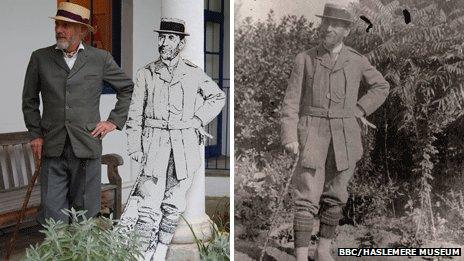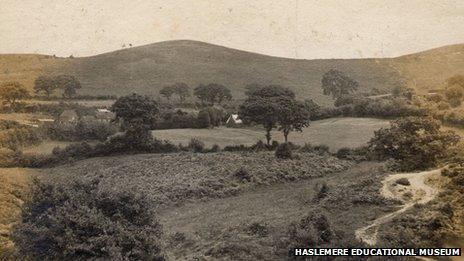National Trust 'quiet man' Sir Robert Hunter remembered
- Published

John Owen Smith, who will play Sir Robert Hunter in a performance in Haslemere, said the National Trust founder preferred quiet persuasion
Sir Robert Hunter was an "unprepossessing" lawyer who shunned the limelight but used his legal knowledge to acquire swathes of countryside for public use as a co-founder of the National Trust. On the centenary of his death, who was the man behind the idea credited with keeping England green?
His unmarked grave's location is shrouded in mystery and there are no markers to show his place of birth.
But Sir Robert's careful work led to the founding of the National Trust and gave it the powers it enjoys today - and the quiet and introverted civil servant will take centre stage on the 100th anniversary of his death.
Haslemere, where Sir Robert lived in Surrey, will see a performance at the museum on the centenary, 6 November, and a talk by the National Trust's director general Dame Helen Ghosh the next day.
The National Trust said Sir Robert's big idea was to use the law as "a battering ram" against landowners to acquire large areas of countryside for the public.
It was a strategy the charity described as a simple concept with huge potential.
And it is thanks to him, the charity said, that London is now one of Europe's greenest cities.
But why is Sir Robert not as well known as the trust he helped create?
'Not much personality'
John Owen Smith, the local historian and playwright who will impersonate Sir Robert, said he was a difficult man to get into.
"He was very quiet, very unprepossessing. He didn't have that much personality and he wasn't much good at public speaking," he said.

A memorial to Sir Robert Hunter stands at Waggoners Wells
"He preferred quiet persuasion, and would rather be pulling levers."
Katherine Jessel, from the Friends of the Parish of Haslemere, and also a local historian, believes his request to be buried in an unmarked grave shows he was "probably genuinely humble."
She said: "I think he had a dry sense of humour. He was an introverted workaholic with a twinkle in his eye."
But she believes he had tremendous foresight: "He saw the way it was going, with roads, buildings and cars."
Ben Cowell, the National Trust's East of England's regional director, said out of the charity's three founders, Sir Robert was less of a public figure.
He said there were various theories about his request for an unmarked grave.
'No grand memorial'
"No-one knows where it is," he said. "It might just be bad record-keeping though he may have been buried at home.
"It's not necessarily that he is an obscure figure. He was not somebody who would have wanted public attention and a grand memorial in his name, or a statue."

A view of Hindhead Commons in the early 1900s when Sir Robert bought the land for the National Trust - one of the charity's first acquisitions
.jpg)
The Hindhead site includes the Devil's Punch Bowl and Gibbet Hill which is said to be where highwaymen were hanged and is Surrey's second highest point
.jpg)
Sir Robert "was very conscious" of the powers he gave to the National Trust when he formed its constitution and purposes, Ben Cowell said
The National Trust was more concerned about the lack of a blue plaque at the place of Sir Robert's birth in Camberwell, south London, he added.
"People have applied twice to English Heritage and it has been rejected both times," he said.
English Heritage said the blue plaques scheme, external which commemorates notable figures and buildings was hugely popular and over-subscribed and difficult decisions had to be made.
"An important factor in the decision not to shortlist Sir Robert was that it was felt commemoration at his Surrey residence, where he lived for over 30 years, would be more appropriate than a blue plaque in London," it said.
"Sir Robert will, however, be eligible for re-proposing for a plaque in 2015."
Haslemere's church has a memorial for Sir Robert, as the first parish council chairman, and a memorial also stands at Waggoners Wells, external.
'Too powerful'
Mr Cowell said: "He was really important to us. He came up with the idea, came up with the name and wrote our founding documents."
Hampstead Heath, Wimbledon Common and Epping Forest were all threatened with development and protected, he added.
.jpg)
Sir Robert was behind the trust's acquisition of Hindhead Commons and the Devil's Punch Bowl in 1906
"The reason London is one of the greenest and woodiest of European cities is because of that movement - using the law to further the aim of saving open spaces," he said.
In the charity's early years, its three founders were busy using legal powers to buy land, he said.
It led to concentrations, external of National Trust sites where they lived, with Sir Robert in Surrey, Octavia Hill in Kent and Hardwicke Rawnsley in the Lake District.
"In Haslemere, he is venerated - almost like a saint," he added.
Sir Robert was behind the trust's acquisition of Hindhead Commons and the Devil's Punch Bowl, external in 1906.
He went on to draft the National Trust Act, which said the charity must hold assets in perpetuity.
But what would Sir Robert think of the National Trust as it is now?
This year, the charity has been criticised by its tenants and has courted controversy over its decision to open the Big Brother house. In the past, it has also been censured for "Disney-fying, external" properties.
Haslemere's historians said if Sir Robert could see the National Trust today, he might think it had grown "too powerful".
Ms Jessel said: "He would be a little bit worried at how big it has grown and whether it can grow any bigger."
But Mr Cowell said: "He formed our constitution and charitable purposes very carefully.
"It gives us all sorts of powers to intervene in things. He was very conscious about what he was doing."
- Published11 October 2013
- Published9 September 2013
- Published30 May 2012
- Published15 September 2011
- Published7 September 2011
- Published14 July 2011
- Published26 November 2010